Are you a new cat owner or looking to upgrade your feline friend’s litter box? Choosing the right litter box for your cat can make all the difference in their comfort and well-being. With so many options available, it can be overwhelming to decide which one is best for your furry companion.
This comprehensive guide will walk you through everything you need to know to make an informed decision.
First, it’s important to understand your cat’s preferences. Does your cat prefer an open or enclosed litter box? Do they like a certain type of litter? These factors can greatly impact your cat’s litter box habits and overall satisfaction. By taking the time to observe your cat’s behavior and preferences, you can make an informed decision on which litter box will be the best fit for them.
Keep reading to learn more about the different types of litter boxes, litter options, maintenance and cleaning, and additional features to consider when choosing the perfect litter box for your furry friend.
Key Takeaways
– Choosing the right litter box is crucial for your cat’s health and happiness.
– Cat preferences for open or enclosed litter boxes and type of litter should be considered.
– Regular cleaning and proper disposal of litter are important for maintaining a clean and sanitized litter box.
– Multiple litter boxes are recommended for households with more than one cat.
Understand Your Cat’s Preferences
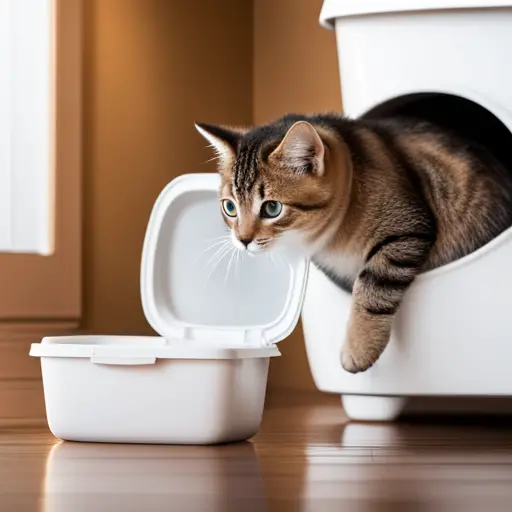
You gotta pay attention to what your cat likes when it comes to litter boxes, or else they might just choose to go elsewhere. Cat behavior and litter box training are important factors to consider when choosing the right litter box for your furry friend.
Some cats prefer covered litter boxes for privacy, while others like open ones that allow them to keep an eye on their surroundings. It’s also important to pay attention to the size of the litter box.
If your cat is larger, they may prefer a bigger litter box to move around in comfortably. On the other hand, smaller cats may feel overwhelmed in a large litter box. By understanding your cat’s preferences, you can choose a litter box that they will feel comfortable using, which will ultimately lead to better litter box habits and a happier cat.
Types of Litter Boxes
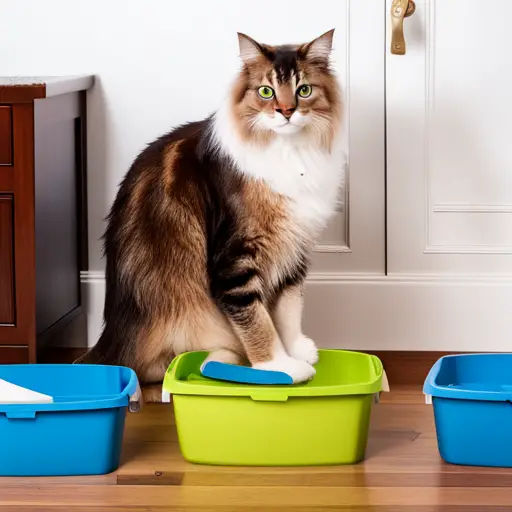
Let’s explore the various types of litter boxes available for our feline friends.
One popular option is the self-cleaning litter box. These litter boxes use sensors to detect when your cat has finished using the litter box, and then they automatically clean themselves. This is a great option for busy cat owners who don’t have the time or energy to clean a litter box multiple times a day. Some self-cleaning options even come with disposable trays, which make cleaning even easier.
Another option to consider when choosing a litter box is decorative designs. These litter boxes come in a variety of colors and patterns, which can add a touch of style to your home. Decorative litter boxes can be disguised as furniture, such as an end table or a plant stand, which can help to camouflage the litter box and make it less noticeable. This is a great option for cat owners who want to keep their home looking stylish and clean while still providing a comfortable and functional space for their cat.
Consider the Litter
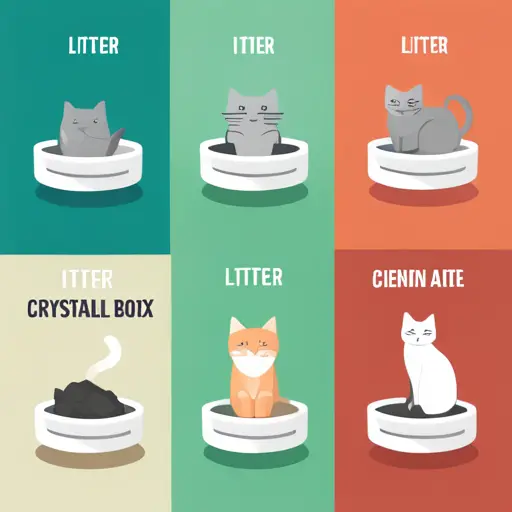
When it comes to choosing the right litter for your cat, there are several factors to consider.
Firstly, you must decide whether to go for clumping or non-clumping litter.
Secondly, you should think about whether you want a scented or unscented option.
Finally, you may want to consider whether you prefer natural or synthetic litter.
All of these factors can affect your cat’s comfort and wellbeing, so it’s essential to make an informed choice.
Clumping vs. Non-Clumping
Clumping litter is made from bentonite clay and forms tight clumps when your cat urinates, making it easy to scoop out and keep the litter box clean. This type of litter is a popular choice among cat owners because it is convenient and helps reduce odor. Here are some benefits of using clumping litter:
– Easy to scoop: Clumping litter makes it easy to scoop out the clumps of urine and feces, which means you can clean the litter box more frequently. This helps keep the litter box fresh and reduces the risk of your cat developing litter box aversion.
– Reduces dust: Clumping litter is less dusty than non-clumping litter, which means it’s better for your cat’s respiratory health. Dust can irritate your cat’s lungs and cause respiratory problems, so choosing a low-dust litter is important.
– Controls odor: Clumping litter helps control odor by forming tight clumps around the urine and feces. This means that the odor is contained within the litter box and doesn’t spread throughout your home.
On the other hand, non-clumping litter is made from materials like clay, silica gel, or recycled paper. This type of litter doesn’t form clumps when your cat urinates, which means it can be more difficult to clean. However, there are some benefits to using non-clumping litter:
– Less expensive: Non-clumping litter is generally less expensive than clumping litter, which can be a factor for some cat owners.
– Lasts longer: Non-clumping litter doesn’t need to be changed as frequently as clumping litter, which means it can last longer. This can be convenient if you have a busy schedule and don’t have time to clean the litter box as often.
– More natural: Non-clumping litter is often made from natural materials like recycled paper or wood chips, which can be more environmentally friendly than clumping litter.
Ultimately, the choice between clumping and non-clumping litter comes down to personal preference and your cat’s needs. Consider factors like scoop frequency, dust control, and odor control when making your decision.
Scented vs. Unscented
Scented litter, infused with perfumes or deodorizers, can be overpowering for some cats and cause respiratory issues, while unscented litter is a safer choice for sensitive feline noses. While fragranced litter boxes can mask unpleasant odors, they may also introduce a new, overwhelming scent to your cat’s litter box. The overpowering aroma may discourage your cat from using the litter box altogether.
Additionally, the chemicals used in scented litters can irritate your cat’s respiratory system, causing coughing, sneezing, and other health issues. On the other hand, unscented litter is a safer choice for cats with respiratory issues or sensitive noses. These litters are free of added chemicals and perfumes, making them a more natural and healthy option for your feline friend.
While they may not have the same odor-fighting power as scented litters, unscented litter boxes are a great alternative for cats that prefer a more subtle scent or no scent at all. Ultimately, the choice between scented and unscented litter boxes will depend on your cat’s preferences and health needs.
Natural vs. Synthetic
Now that you’ve learned about scented and unscented litter boxes, it’s time to explore the difference between natural and synthetic options. While both types have their own benefits, choosing an eco-friendly option that considers your cat’s health is important.
Here are some key points to consider when deciding between natural and synthetic litter boxes:
– Eco-friendly options: Consider choosing a litter box made from sustainably-sourced materials. This can include litter boxes made from recycled paper, bamboo, or wheat. Not only do these options reduce your carbon footprint, but they also promote a healthier planet for future generations.
– Health considerations: Synthetic litter boxes may contain chemicals and fragrances that can irritate your cat’s respiratory system. Natural litter options, on the other hand, often have fewer chemicals and are biodegradable, making them a safer option for your furry friend and the environment.
– Odor control: Some natural litter options, such as pine or cedar chips, have natural odor control properties. However, synthetic litter options may contain added fragrances to help mask unpleasant smells.
– Cost: While synthetic litter options may initially appear more cost-effective, natural options may last longer and require less frequent changing, ultimately saving you money in the long run.
Remember, when choosing between natural and synthetic litter boxes, it’s important to prioritize both your cat’s health and the environment. By considering eco-friendly options made with natural materials, you can promote a healthier planet while also providing a safe and comfortable space for your feline friend.
Maintenance and Cleaning
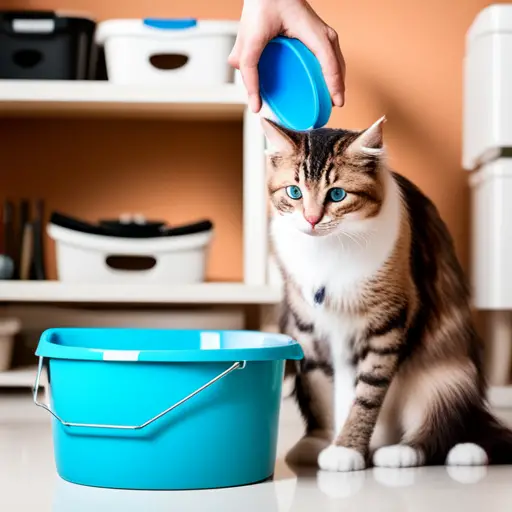
Keeping your cat’s litter box clean and sanitized is crucial for their health and happiness. Not only does a dirty litter box lead to unpleasant odors, but it can also cause your cat to avoid using it altogether.
To prevent this from happening, it’s important to clean the litter box on a regular basis. The cleaning frequency will depend on the number of cats you have and how often they use the litter box. As a general rule, you should scoop out solid waste and clumps of urine at least once a day.
In addition to scooping out waste, you’ll also need to dispose of the litter properly. Avoid flushing litter down the toilet, as it can lead to plumbing issues and harm the environment. Instead, place the used litter in a trash bag and dispose of it in your regular garbage bin.
When it comes to location placement, make sure the litter box is in a quiet and private area of your home. This will help your cat feel more comfortable and less stressed while using it. Lastly, make sure the litter box is large enough for your cat to comfortably move around in, and that there is enough space for them to enter and exit the box easily.
By following these tips, you can ensure that your cat’s litter box is always clean, sanitized, and inviting for them to use.
Additional Features
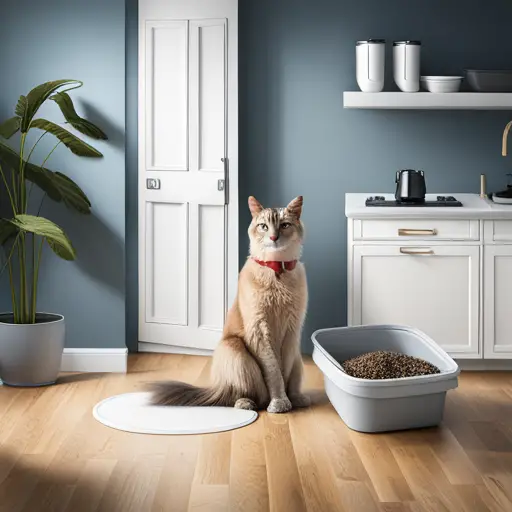
When choosing a litter box for your cat, you may want to consider additional features that can improve your cat’s experience and your own.
Odor control is an important feature to look for, as it can help reduce unpleasant smells in your home.
Privacy hoods can also be beneficial for cats who prefer a more secluded space, and litter boxes designed for multiple cats can accommodate households with more than one feline friend.
Odor Control
To keep your home smelling fresh and clean, you’ll want to choose a litter box that effectively controls odors. One way to do this is by using litter box liners. These are plastic bags that go inside the litter box and make it easier to dispose of waste. They also help to prevent odors from seeping into the litter box itself, making it easier to keep the box clean and smelling fresh.
Another way to control odors is by using litter box deodorizers. These are special powders or sprays that you can use to neutralize the smell of cat urine and feces. Some deodorizers are scented to provide a pleasant fragrance, while others are unscented and simply work to eliminate odors. Whichever type you choose, be sure to follow the instructions carefully to avoid any adverse effects on your cat’s health.
With the right litter box and odor control measures, you can ensure that your home stays fresh and clean, even with a furry friend in the house.
Privacy Hoods
If you want to give your furry friend some much-needed privacy, you should consider adding a privacy hood to their litter box. Not only will this provide a sense of security for your cat, but it’ll also keep any unpleasant odors at bay.
Here are some benefits of privacy hoods:
– Increased privacy for your cat: Cats are naturally solitary animals and prefer to do their business in private. A privacy hood gives them the space they need to do just that.
– Reduced litter scatter: Hoods help keep litter contained, reducing the amount of litter that gets scattered around your home.
– Aesthetically pleasing: Privacy hoods come in a variety of colors and styles, so you can find one that matches your home decor.
But if you prefer hoodless options, there are still ways to give your cat some privacy. You can place the litter box in a more secluded area, such as a closet or bathroom, or you can use decorative privacy add-ons like screens or curtains.
Ultimately, the important thing is that your cat feels comfortable and secure while using their litter box.
Multiple Cat Use
Having multiple cats can be a challenge when it comes to litter box use. Sharing spaces can lead to territorial disputes and litter box problems. One way to prevent this is by providing multiple litter boxes in different locations throughout your home.
If you have more than one cat, the general rule is to have one litter box per cat plus an extra one. This gives them enough options to choose from and reduces the likelihood of litter box issues.
Introducing new cats to your household can also affect litter box use. It’s important to provide a separate litter box for the new cat until they are fully integrated into the household. This helps prevent any territorial disputes and ensures that each cat has their own space to use the litter box.
When introducing a new cat, it’s also important to monitor their behavior around the litter box and make any necessary adjustments to ensure that all cats are using the litter box appropriately. With the right steps taken, multiple cats can share a litter box without any issues.
Conclusion
Congratulations! You’ve made it to the end of our comprehensive guide on choosing the right litter box for your feline friend. By now, you should have a clear understanding of your cat’s preferences, the different types of litter boxes available, and the importance of considering the litter and maintenance of the box.
Remember, the key to finding the perfect litter box for your cat is to take into account their individual needs and behaviors. Don’t be afraid to try out different options until you find the one that works best for your furry companion.
With the right litter box, you can provide your cat with a clean and comfortable space to do their business. This ultimately leads to a happier and healthier pet.
